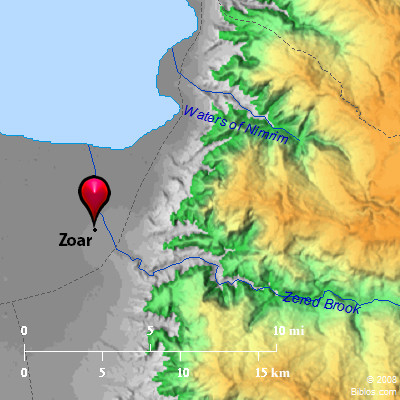Atlas  Zoar and surrounding area Maps Created using Biblemapper 3.0 Additional data from OpenBible.info Occurrences Genesis 13:10 Lot lifted up his eyes, and saw all the plain of the Jordan, that it was well-watered everywhere, before Yahweh destroyed Sodom and Gomorrah, like the garden of Yahweh, like the land of Egypt, as you go to Zoar.Genesis 14:2 that they made war with Bera, king of Sodom, and with Birsha, king of Gomorrah, Shinab, king of Admah, and Shemeber, king of Zeboiim, and the king of Bela (the same is Zoar). Genesis 14:8 The king of Sodom, and the king of Gomorrah, and the king of Admah, and the king of Zeboiim, and the king of Bela (the same is Zoar) went out; and they set the battle in array against them in the valley of Siddim; Genesis 19:22 Hurry, escape there, for I can't do anything until you get there." Therefore the name of the city was called Zoar. Genesis 19:23 The sun had risen on the earth when Lot came to Zoar. Genesis 19:30 Lot went up out of Zoar, and lived in the mountain, and his two daughters with him; for he was afraid to live in Zoar. He lived in a cave with his two daughters. Deuteronomy 34:3 and the South, and the Plain of the valley of Jericho the city of palm trees, to Zoar. Isaiah 15:5 My heart cries out for Moab! Her nobles flee to Zoar, to Eglath Shelishiyah; for they go up by the ascent of Luhith with weeping; for in the way of Horonaim, they raise up a cry of destruction. Jeremiah 48:34 From the cry of Heshbon even to Elealeh, even to Jahaz have they uttered their voice, from Zoar even to Horonaim, to Eglath Shelishiyah: for the waters of Nimrim also shall become desolate. Encyclopedia ZOARzo'-ar (tso`ar; the Septuagint usually Segor, Zogora): The name of the city to which Lot escaped from Sodom (Genesis 19:20-23, 30), previously mentioned in Genesis 13:10; Genesis 14:2, 8, where its former name is said to have been Bela. In 19:22, its name is said to have been given because of its littleness, which also seems to have accounted for its being spared. The location of Zoar has much to do with that of the cities of the Plain or Valley of Siddim, with which it is always connected. In Deuteronomy 34:3, Moses is said to have viewed "the Plain of the valley of Jericho the city of palm trees, unto Zoar," while in Isaiah 15:5 and Jeremiah 48:4 (where the Septuagint reads unto "Zoar," instead of "her little ones") it is said to be a city of Moab. The traditional location of the place is at the south end of the Dead Sea. Josephus says (BJ, IV, viii, 4) that the Dead Sea extended "as far as Zoar of Arabia," while in Ant, I, xi, 4, he states that the place was still called Zoar. Eusebius (Onomasticon, 261) locates the Dead Sea between Jericho and Zoar, and speaks of the remnants of the ancient fertility as still visible. Ptolemy (v. 17, 5) regards it as belonging to Arabia Petrea. The Arabian geographers mention it under the name Zughar, Sughar, situated 1 degrees South of Jericho, in a hot and unhealthful valley at the end of the Dead Sea, and speak of it as an important station on the trade route between Akkabah and Jericho. The Crusaders mention "Segor" as situated in the midst of palm trees. The place has not been definitely identified by modern explorers, but from Genesis 19:19-30 we infer that it was in the plain and not in the mountain. If we fix upon the south end of the Dead Sea as the Vale of Siddim, a very natural place for Zoar and one which agrees with all the traditions would be at the base of the mountains of Moab, East of Wady Ghurundel, where there is still a well-watered oasis several miles long and 2 or 3 wide, which is probably but a remnant of a fertile plain once extending out over a considerable portion of the shallow south end of the Dead Sea when, as shown elsewhere (see DEAD SEA), the water level was considerably lower than now. |



